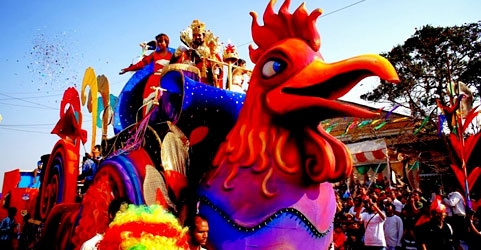During Goa carnival, every year a person from the is chosen to play King Momo – a mythological character who symbolically rules the state during the carnival time and leads the float parades held across Goa.
PANAJI: The popular annual Goa Carnival will be held across the coastal state from February 10 to 13. The main float parade of the festival will be held in the state capital Panaji on February 10 and ‘King Momo’ will lead the float parades in all the major cities of the state. Every year, a person from the state is chosen to play King Momo – a mythological character who symbolically rules the state during the carnival time and leads the float parades held across Goa.
This year, Bruno Azaredo (57), from Utorda village in South Goa district, has been selected to play the role of King Momo and lead the float parades, a spokesman of the state tourism department said.
State tourism minister Manohar Ajgaonkar earlier took stock of the preparations, including security and traffic arrangements, for the four-day festival. The float parades will be held in Margao and Ponda on February 11, Vasco and Curchorem on February 12 and in Mapusa and Morjim on February 13, he said.
The carnival committees, set up by the tourism department, have been asked to encourage participants to promote the state’s culture and traditions in the festival and minimise the commercialisation of floats, he said.
“The vehicles which cause pollution will not be allowed in the parades. The consumption of liquor and carrying of weapons will also not be permitted during the event,” the spokesman said.
The carnival is being celebrated in Goa since the 18th century and is meant for enjoyment and merry-making, just before the 40 days of Lent, which is the time of abstinence and spiritual preparation for Easter, one of the organisers said.
The festival was introduced by the Portuguese, who ruled Goa for over 500 years, he added.
Goa carnival was brought to India by Portuguese during the time they ruled here and approximately 500 years ago the first every carnival was organised in the state. But it was not the Portuguese originally who had these kind of exuberant riotous celebrations, the culture actually came from ancient Rome and Greece and spread to Spain and Portugal eventually. This quite explains that when Portuguese colonised Goa they wanted their culture to be dominant here and hence this carnival was organised. It had a Portuguese flavour to it earlier but with time the celebrations have taken up the essence of Goan culture and thus people identify with the festivities and take part in the carnival in crazily large numbers.
There are no entry tickets for the carnival and you just have to come and take part in the celebrations. Everyone is invited with open arms to join in and revel in the four days of exhilaration and unmatched exuberance.
There would be no doubt in your mind by now that Goa Carnival is the most awaited event in the state. You can get this from the fact that preparations start in December to make the carnival a roaring success! Music, dance and entertainment are the shining features of the carnival and along with these there are plays of a short length which portray the Goan traditions and culture very beautifully.
It is organised before the month of Lent is going to begin when people would have to completely abstain themselves from the consumption of meat. Starting with a grand procession on the Fat Saturday evening, the parade is lead by King Momo who sets out with his entourage of dancers, bands, clowns, acrobats and other entertainers to spread the message of merry making across the state.
The parade moves down through the main street of Panaji, the capital city of Goa? to come to rest after some hours of what seems like “endless gaiety”. The festivities end with red and black dance where women and men dresses in red coloured upper garments and black coloured lower garments dance to the beats of the bands in a festooned procession. Ash Wednesday as it is called is the last day of the carnival when the month of Lent begins. One thing to note is that the feasting is a major part of the festivities and hence this is time for the foodies to venture out and taste some of the best cuisines, drinks and wines here. Pure indulgence, we must say!
Booking hotels and travel tickets well in advance will be of huge benefit because you might get your hands on attractive discounts with early booking. Also, advance planning and booking will be good because you would not like to get stuck in the rush hour as Goa is flooded with tourists during the time of carnival.
Take your best clothes with yourself and get ready to rock the carnival and also don’t wear any shoes that are uncomfortable or may give you a shoe bite as there are a lot of street activities which you may be taking part in.
